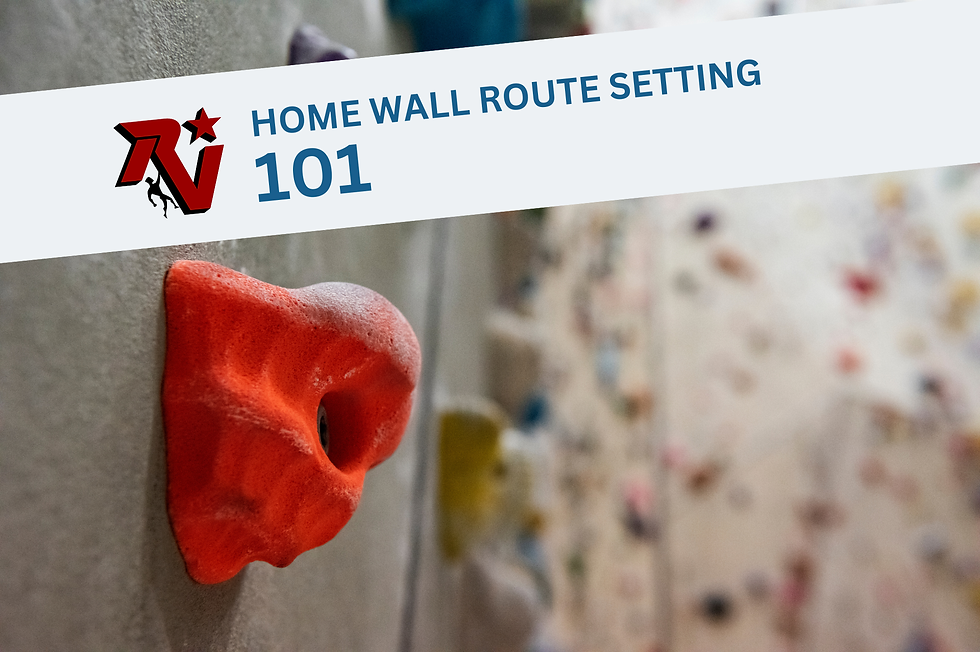The 5 Climbing Holds You Need to Maximize Your Home Climbing Wall
- Dovi Hirsch
- Jun 13, 2021
- 4 min read
by Christopher Schafenacker

Your Rocket Wall home woody has just arrived. You’ve already drooled all over the package, you’ve cleared a space in your garage, your tools are ready, your palms are sweaty, and you’re about to get started on the build when you realize you’ve forgotten one crucial detail: holds. Briefly, you consider training your mono strength on the pre-installed T-nuts but discard the idea when you remember that your fingers are about as thick as they are long. Desperate, you turn to the internet to find out whether any climbing hold company offers same-day shipping and in the process, you realize you first need to figure out which kinds of holds to buy. The guide below arrives as your savior.
5 Hold Types to Help You Milk the Most from Every Session
The ideal hold set is the one that you’ll use the most. This will, of course, differ depending on your skill level and climbing goals and will change over time. Nonetheless, every board needs to cover some basics in order to fulfill its purpose as a complete training tool. This means that unless you’re training with a hyper-specific objective in mind, you’ll want to set your woody with a balance of the following:
1. Jugs
It can be easy for anyone psyched enough to invest in a home climbing wall to overlook the need for big, comfy jugs, and yet these are a vital part of any effective design. Begin each re-set by spraying a range of creatively-oriented jugs in an X-shape across your board and not only will you gain necessary warm-ups, but you will also lay the foundation for moves that test more than just finger strength (the perennial problem of board training).
2. Crimps
Crimps, crimpers, edges… whatever you want to call them, these will be a staple of your board diet. Why? Because when creatively set, crimps pack a lot of punch into a small space by creating techy problems that demand precision, tension, and tendons of steel. So much so is this the case that a new word has entered the climbing vernacular: “board-style” to describe routes with these precise characteristics.
3. Open-Hand Grips
You can’t live on a diet of crimps for long without getting injured. That, and without variation in your training, you won’t improve. This is where open-hand grips—that is, flat edges and slopers—come in. By allowing dynamic- and compression-focussed movement without the same risk of injury as crimps, such holds allow you to work power and coordination on your board, as well.
4. Volumes
A couple of well-chosen and well-designed volumes provide the versatility of cranking up or dialing back the angle of your board while at once relieving the monotony of always climbing in the same, squared-off stance. Slap a volume on up high and all of a sudden you’re pulling a roof; screw one on down low and enjoy the terrifying feeling of friction feet on a slab.
5. Feet
Speaking of feet, investing in a variety of foot chips should not be overlooked. It may be that the crusty old crusher at your crag believes you need no more than a dozen beer caps screwed onto your kicker to train at home, but this is only true if you want to forever climb a variation on the same problem. With a range of feet to choose from, you can set traverses, circuits, and all other kinds of inventive boulders that you simply cannot create if following a strict, feet-follow-hands setting ethic.
Just as important as hold variety on your board is hold orientation. After all, outdoor routes are rarely a simple matter of grabbing and pulling. By playing with orientation, you can manufacture underclings, gastons, high steps, and other tricky moves that will help you target weakness and prepare to crush not only in your garage but at the crag, too.
To learn more about setting up a home wall and ensuring you get the most out of your rig, don’t hesitate to contact Rock Star Volumes with any questions or curiosities.
Featured Climbing Training Gear
*NEW* The Rocketeer Wall: our free-standing adjustable solution for those who can’t mount a hangboard anywhere in their home or apartment—or who are limited on space. The Rocketeer gives climbers the additional option to set specific climbing holds. Recreate the crux holds of your proj and get ready to send, bruh.
The Rocket Wall: Available in 6’ and 8’ widths, it’s been tough for us to keep up with the demand for this innovative home climbing wall solution. Slightly overhanging, the Rocket Wall is big enough to set routes on, or to build a systems board.
The Rock-Stah: Our handcrafted version of a traditional hangboard, with curving crimp rails to help alleviate unnecessary strain on your pulleys. Because ain’t no one got time for a finger injury…
Works Cited:
Heyman, E., De Geus, B. A. S., Mertens, I., & Meeusen, R. (2009). Effects of four recovery methods on repeated maximal rock climbing performance. Medicine & Science in Sports & Exercise, 41(6), 1303-1310.
Watts, P.B., Daggett, M., Gallagher, P., Wilkins B., Metabolic Response During Sport Rock Climbing and the Effects of Active Versus Passive Recovery (2000). Int J Sports Med, 21:185– 190.
Wilson, J. M., Marin, P. J., Rhea, M. R., Wilson, S. M., Loenneke, J. P., & Anderson, J. C. (2012). Concurrent training: a meta-analysis examining interference of aerobic and resistance exercises. The Journal of Strength & Conditioning Research, 26(8), 2293-2307.
Augste, C., Winkler, M., Künzell, S. Entwicklung einer wissenschaftlich fundierten Leistungs-diagnostik im Sportklettern (2020). Augsburg University.










Comments